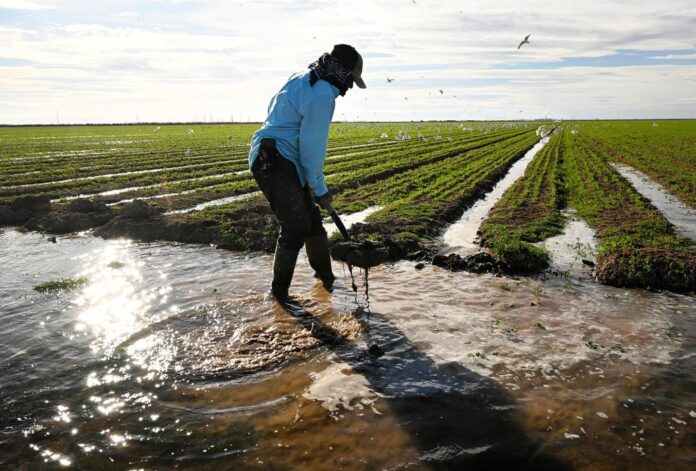In recent days the states of Colorado, New Mexico, Utah, and Wyoming submitted an alternative plan outlining the proposed operations of Lake Powell and Lake Mead after 2026.
Woven throughout this alternative plan submitted to the U.S. Bureau of Reclamation by these Upper Basin Division States is the need to restore balance to the vital lifeline of the West — The Colorado River.
Righting the imbalances that have caused these two reservoirs to drop to historic and critically low volumes will require more assurances than are contained in the 2007 operating guidelines or the plan currently proposed by California, Arizona, and Nevada, the Lower Division Basin states.
It’s a positive step that the Lower Basin states have acknowledged their role in this imbalance, but we are deeply troubled by their assertion that additional constraints be placed on Upper Basin water users when we use just over half of our legal apportionment.

The 1922, the Colorado River Compact attempted to provide certainty and security of water supplies for both the Upper and Lower Basins. But today’s hydrologic reality is much different than a century ago. Persistent drought has diminished river flows which, combined with chronic overuse by the Lower Basin, now poses risks to the entire Basin.
Shortages that we have experienced in recent years resulted in significant impacts to the livelihoods of Colorado water users. The Upper Basin’s alternative plan provides an opportunity for Lower Basin states to share the burden of climate change more fairly, a burden that Upper Basin water users have been primarily shouldering for decades.
In addition, the alternative supports sustainable operations of the lakes Powell and Mead based on actual hydrology (as opposed to forecasts), helps rebuild critical storage, and avoids large variations in release volumes. Notably, this proposal from Colorado, New Mexico, Utah, and Wyoming does not place the importance of one user over another; rather, it recognizes that water supply security applies to all.
The Upper Basin has always lived within its allowed apportionment and even today we typically use less than 70% of what the Compact has allotted us.
In 2021 our Colorado River use was less than half our allocation because we largely rely on snowpack, and for 2021, the water supply simply did not exist.
Yet the Lower Basin used more than its allocation that year because its water uses are largely supplied from the storage provided in Lakes Mead and Powell. Such releases have not been aligned with the available water supply for some time, which has drained these reservoirs. This resulting imbalance has landed us where we are today: the nation’s two largest reservoirs are at critically low levels and the operations of the Colorado River is in a constant state of crisis management.
The Lower Basin acknowledges the need and responsibility to address the system imbalance, and we fully support this first step. We will be interested to learn more about how they will accomplish this. However, any proposal to access Upper Basin storage to offset Lower Basin uses is extremely concerning. Additionally, equal reductions, when total storage of Lakes Mead and Powell drops below 38% fails to recognize that when water is not available, Upper Basin water uses have already been reduced.
In Colorado, we are doing what we can to use our Colorado River supplies wisely through aggressive conservation programs and investments in water reuse systems. Colorado and the other Upper Basin Division States will continue to manage their water supplies and demands responsibly. These and other parallel activities outlined in the upper basin alternative focus on bringing uses into balance with available supplies to provide more certainty for all who rely on this mighty river.
Historically, the Colorado River Basin states have demonstrated success through collaboration, and we support the work toward a consensus across the Basin that includes Upper Basin Tribes and other stakeholder considerations.
Certain realities are clear however, operations must be based on actual conditions – not wishful thinking. The idea that depleted storage in Lakes Powell and Mead can be replenished with a few good snowpack years in the Upper Basin is not only unrealistic, it’s irresponsible. The Upper Division State’s Alternative is designed to rebuild storage and protect Lake Powell’s ability to release water downstream in accordance with existing law.
We have adapted to less water availability and will continue to seek ways to continue to be wise stewards of our Colorado River. We’ve also consistently met our compact obligations and ensured that the Lower Basin received its Colorado River apportionment. Together, we should strive for operational guidelines that provide for added certainty and durability in a future with less supply.
Marshall Brown is the general manager of Aurora Water and chair of the Front Range Water Council whose members also include Denver Water, Colorado Springs Utilities, the Northern Colorado Water Conservation District, the Twin Lakes Reservoir and Canal Company and the Southeastern Colorado Water Conservancy District. Alan Salazar is the CEO of Denver Water and vice chair of the Front Range Water Council. Andy Mueller is the general manager of the Colorado River District, created by the Colorado General Assembly in 1937 to protect the Colorado River. Steve Wolff is the general manager of the Southwestern Water Conservation District, created by the General Assembly in 1941 to protect the water basin of nine counties in southwestern Colorado.
Sign up for Sound Off to get a weekly roundup of our columns, editorials and more.
To send a letter to the editor about this article, submit online or check out our guidelines for how to submit by email or mail.



